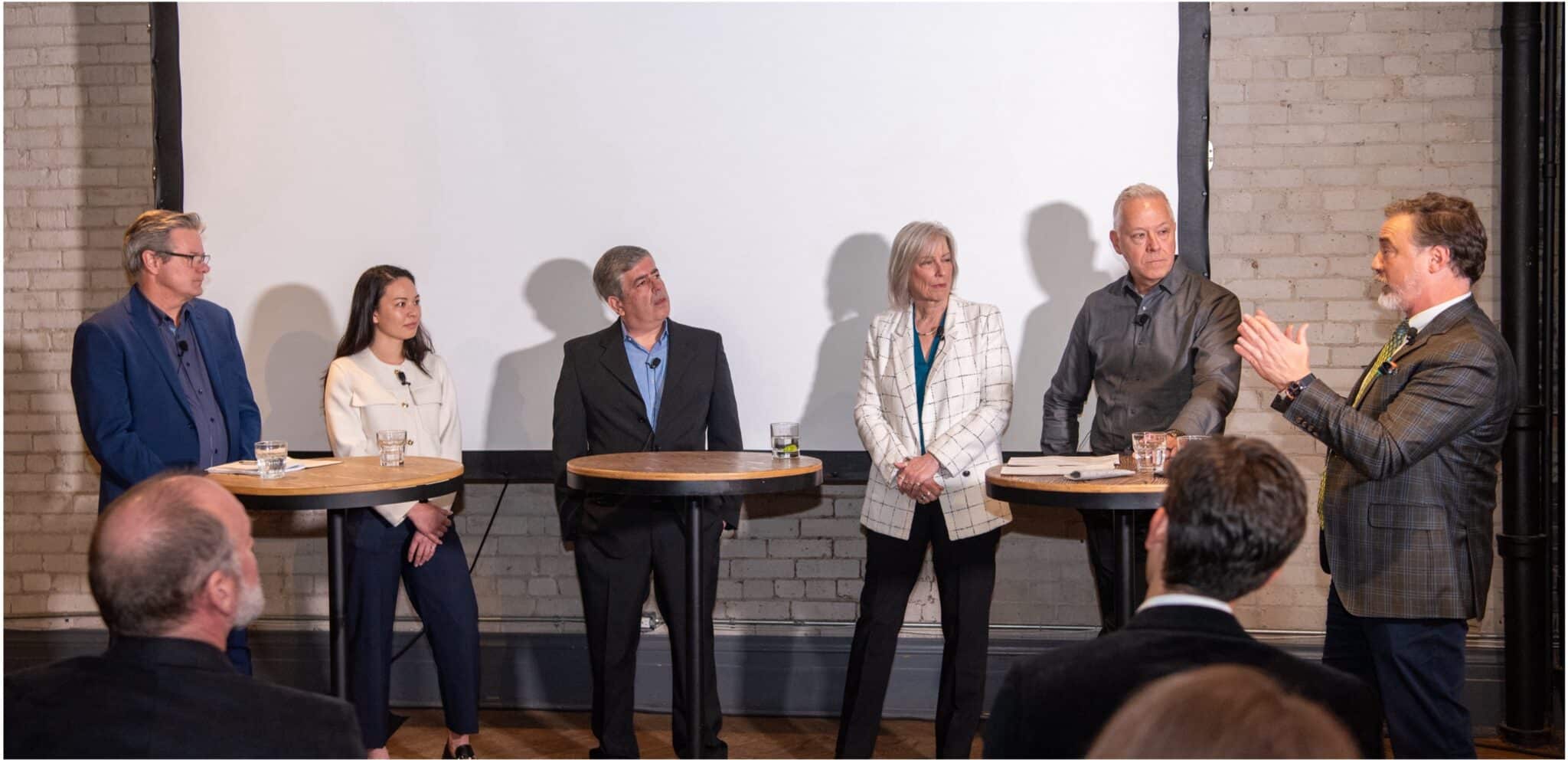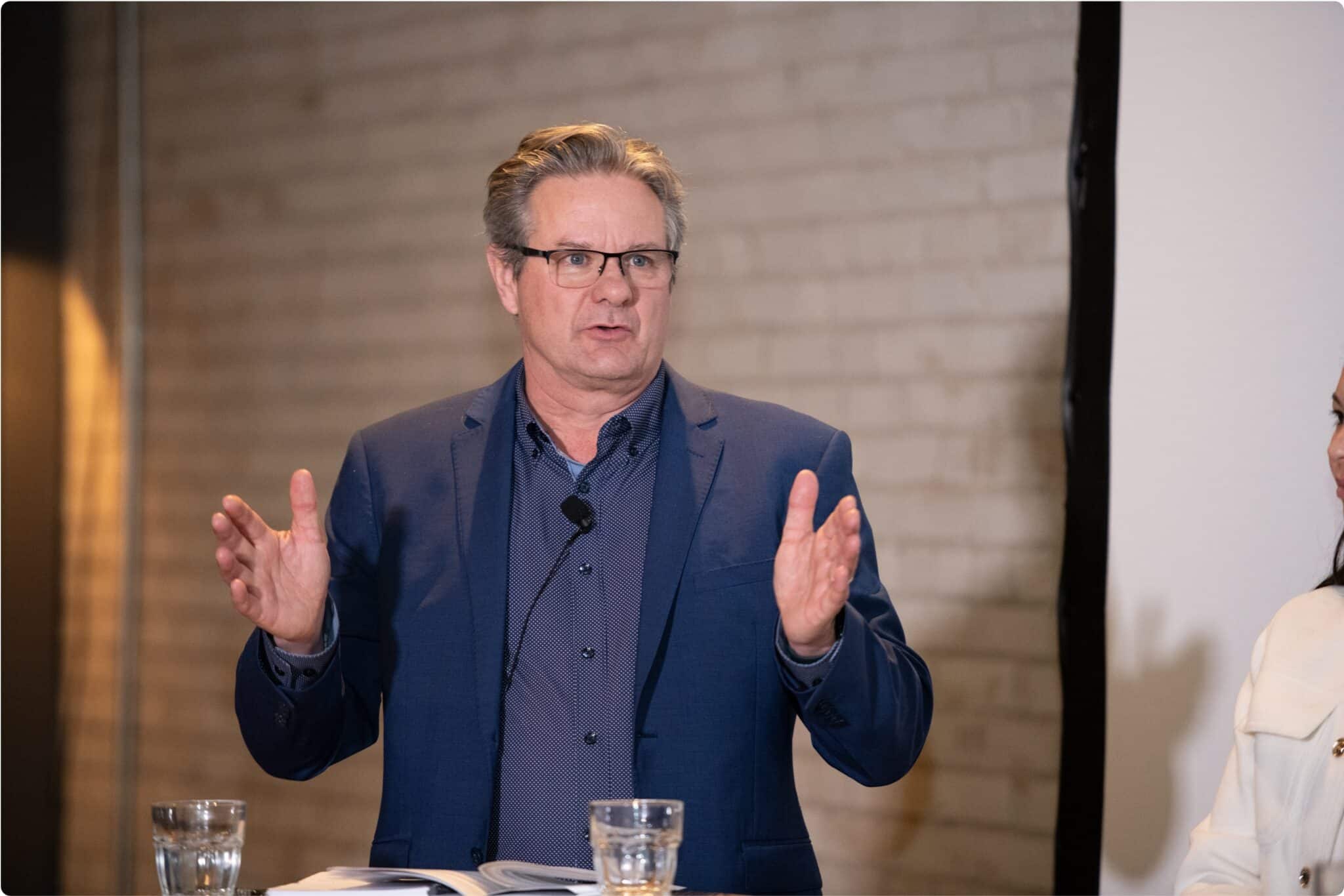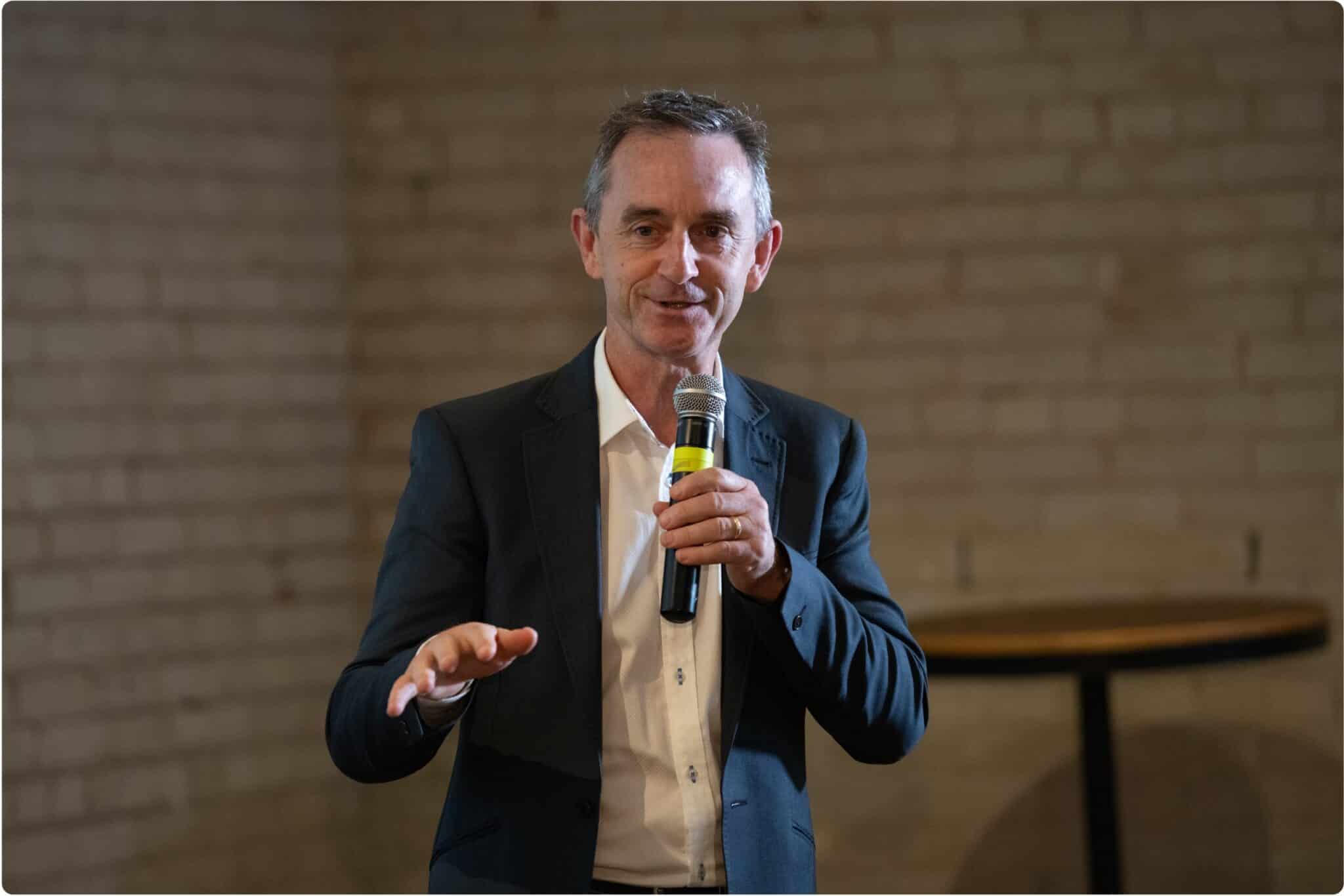Six expert panellists share their views on what excites them – and perplexes them – about the future of mining: How can the industry drive profits and transform practices and outcomes through the latest advances in subsurface technology and analysis?
How many of us rely on good subsurface intelligence? 10,000? 100,000?
How about everyone on the planet?
Whatever we buy, or use, or consume, mining will have played a part in it somewhere. Which means that at some point – maybe many points – the lives we lead are being made possible by a better understanding of the underground.
So where do we go next to make that understanding stronger, clearer and better tailored to the sustainability transitions that need to come; the transitions that will ensure all those lives – and the industries that serve them – advance and prosper?

Rob Ferguson, left, Shelby Yee, Marcelo Godoy, Sally Goodman, John Vandermay and Anthony Vaccaro
in Toronto on March 4. Photo Credit: Seequent
During the recent PDAC – the world’s premier mineral exploration and mining convention – Seequent’s symposium on Subsurface Intelligence set about exploring those challenges, with keynote Futurist Nikolas Badminton, opening remarks with Graham Grant, CEO of Seequent, and a panel including John Vandermay, Chief Technology Officer at Seequent; Sally Goodman VP of Generative Exploration at Newmont; Marcelo Godoy, Chief Technology Officer of Anglo Gold Ashanti; Shelby Yee, CEO and Founder of RockMass Technologies; and Rob Ferguson, Director of Mineral Exploration at Seequent.
Coping with the huge growth in mineral demand
One undisputed conclusion was that the world needs more mining to achieve its ambitions of cleaner energy, reduced emissions, ubiquitous electric transport and more. All rely on harvesting an ever-growing quantity and quality of crucial minerals.
(The bank’s 2020 Climate Change report estimated that at least 3 billion tons of minerals and metals would be needed to enable wind, solar and geothermal power.) So, it’s plain that no serious reduction in emissions can be achieved without the right minerals to enable the right technology.
But the deposits critical to these ambitions are far removed from the easy finds and straightforward exploration that typified past discoveries. They will sit under hundreds of metres of cover, within complex geology, in remote locations.
”Exploration, is getting really hard…
Marcelo Godoy
“Finding deposits is hard. Getting the right prospectivity models is hard…. It really requires a change in paradigm if we want to start finding these new deposits. Because the old prospector walking in the field, like it used to be, is not going to work anymore.”
More data, and more routes to finding it
Better ways of gathering and interrogating data will be vital for that shift, argued Rob Ferguson, but the advancing capabilities of geophysical analysis and instrumentation will also be fundamental to solving the challenges of tougher exploration. Drones that can fly closer and lower to the ground, miniaturisation, sensors that can penetrate deeper, supported by smarter software will have an increasing role and responsibility in finding the next 20 years’ worth of deposits to take us through energy transition.

Rob Ferguson, Director of Mineral Exploration at Seequent
“Importantly, actionable subsurface modelling
involves taking all this data, all this information
from different scanning technologies, and getting
it out of silos and putting it into the Cloud.
Make it accessible from anywhere to anyone.
That’s something we at Seequent have been
working with businesses to try to do.”
Get there faster
A rewarding place to start with data is speeding up the process of geological modelling, declared Seequent CTO John Vandermay. “The normal cycle of drilling and lab analytics, resource modelling and economics can take a whole year or so. That’s just not efficient.” The industry needs to move faster and with more confidence, and to do that “we need to normalise that data and put it into the Cloud and make it accessible,” echoed Vandermay.
Shelby Yee was encouraged by the growing number of creative new data technologies and data collection solutions. For example, RockMass is providing coloured LIDAR images to production geologists so they can update their model in real time. Ideon has been working with BHP to map one and a half billion cubic metres of the subsurface using muon tomography. Or Novamera, which is able to extract ore from narrow veins that are steeply dipping.
”There are so many subsurface technologies becoming available to us, all of them aimed at one goal – to be able to mine more precisely.
Shelby Yee
Where does AI fit into this?
While AI can be hugely effective at marshalling data and extracting value from it, we still need effective ways of coupling those insights to the intuition of a good geologist, noted Sally Goodman.
A purely data-driven system will always be backwards looking. “But the next deposit is never a mirror image of the last one, so it’s about combining the experience and understanding in a geologist’s head with the vast potential for churning through data that AI gives us.”
Nikolas Badminton looked forward to the fast-approaching era of conversational AI as one way to deliver this new model of subsurface intelligence, aiming for a point where: “you simply have a conversation with it and tell it your problems. You ask it to investigate data in whole new ways. There’s a huge advantage to that, especially with the vast amount of data we will all be dealing with.”
He also saw automation as a major part of mining’s revolution. “We know it’s coming to the mining market and while it’s still expensive equipment at the moment – we’re not suddenly going to buy a ton of it – it will be a huge market size in ten years’ time. The advances, the technologies, the capabilities, and the ability to access this technology is going to get cheaper over time, and we’ll see more and more of it out there.”
Finally, does mining have a messaging problem and how do businesses prepare themselves for their next steps?
While mining is at the sharp end of this sustainability shift, there is often a disconnect between the efforts it’s making behind the scenes, and the public’s perception of its enthusiasm for the race to a greener world, argued Sally Goodman. As an industry, mining is not good at getting its message out to the world, “we like to keep our heads below the parapet and not talk too much about what we’re doing. But here we have a situation that we need to tell the world about: that if you want a post carbon economy, you have to mine more.
”It’s a habit we need to break. We need to be more comfortable about getting that narrative across.
Sally Goodman
How? With the data.
Being able to geospatially search across and leverage your data assets, is instrumental in understanding what you’re working with, and the true potential any new find may hold. Also, the importance of being able to make real time decisions on a daily basis is essential if mining companies are to pivot rapidly enough t to seize new opportunities, reduce risk, and bridge any gap in public perception of the mining industry.
Mining makes life possible. It underpins every single thing on the planet, said Graham Grant.

Graham Grant, CEO, Seequent
“Seequent has a singular role to help people understand the underground through subsurface intelligence.”
Hear more from Graham in an interview with Battery Commodity on youtube
But the key to leveraging all these subsurface intelligence solutions lies in taking small, practical sensible steps, said Shelby Yee; low-risk, high-reward implementations or technology adoptions. “If you go to the gym and start by lifting the heaviest weights, you’re going to have a bad time…” But taking steady steps to capture and manage data in a structured, consistent way “builds a foundation and turns knowledge into wisdom.”
”"If we can build this understanding, we can build a better future on the planet."
concluded Graham Grant.





